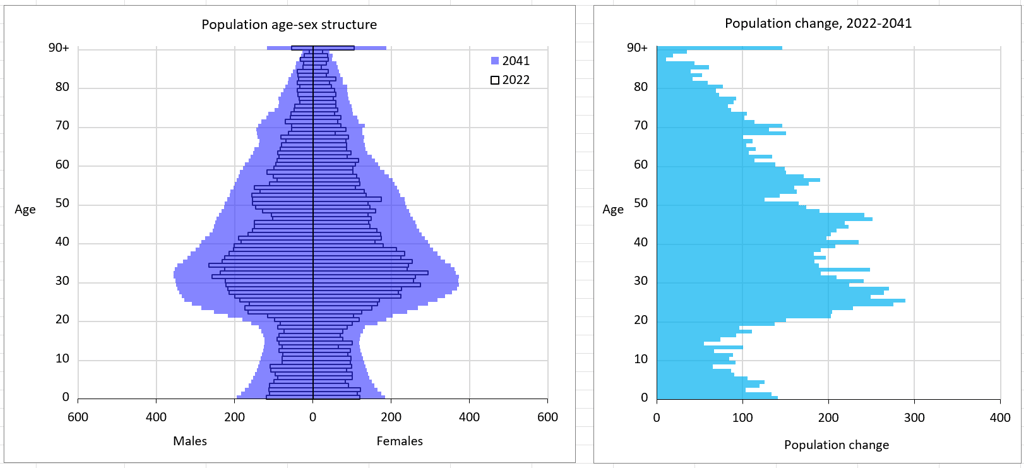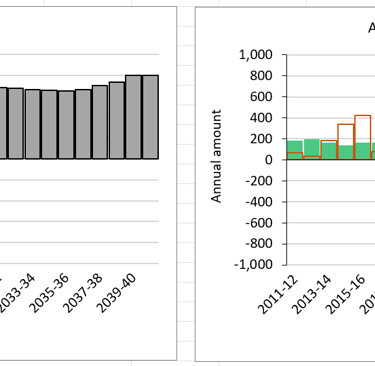STATEPOP demographic projections program
Who will find STATEPOP useful?
The program was designed for use by Australian State and Territory Governments wanting to produce State and local area population and household projections for planning and policy purposes. However, forecasters in other organisations (and in countries other than Australia) who want to prepare projections for any large subnational area and local areas within it are also likely to find the program useful.
What skills are needed to use STATEPOP?
The program is best used by experienced demographers who are familiar with the cohort-component model, life tables, demographic data, and Microsoft Excel. Alternatively, we can run the projections program for you on your behalf based on agreed projection assumptions.
What outputs does the program produce?
The program produces:
(1) summary output files of populations by sex (females, males, and persons) and age group (single years of age, 5 year age groups, and custom age groups), summary demographic components (total births, deaths and migration flows), and median age; also included are several graphs of past and projected populations and demographic components
(2) detailed output files of all projected populations and demographic components by sex and single years of age for every year of the projection horizon
(3) projected rates of fertility, mortality and migration by sex and single years of age (including local area rates after constraining to the State-level projections)
(4) household output files which contain projections of the number of households, average household size, and persons by living arrangement.
STATEPOP can also create projections for up to 5 additional output geographies based on a concordance from the main set of local areas.
What sort of local areas can be included?
Local areas are typically SA2 areas, but they could be any sub-state geography that it is possible to obtain Estimated Resident Populations for (e.g. SA3 areas; local government areas). The minimum recommended local area population size is 3,000 people.
What are the main advantages of STATEPOP?
The program is provided in an easy-to-use Excel workbook.
The projections require only a limited amount of migration input data from users. A special feature of the program is that all migration rates by age and sex are estimated by a synthetic migration estimation method (which is an extension of the method described in the paper here). This avoids all the time and cost involved in preparing detailed local area migration input data. This approach also means that migration rates can be estimated for local areas where there is no actual migration data available (due to boundary changes or because migration statistics are not produced for the chosen local area geography). The migration data estimated by this process has been proven to be high quality, and is particularly adept at handling migration in and out of areas with relatively large non-private dwelling populations.
The projections require only a small amount of mortality inputs from users. Death rates by age and sex are estimated by the program from life expectancy at birth assumptions and a mortality surface contained within the program (consisting of a set of model life tables). This saves considerable time and effort in preparing local area death rate inputs, and the method generates smooth age profiles of local area projected death rates.
For rapidly-growing local areas with new housing, the model allows you to borrow migration rates from another area.
It also produces household projections.
Conversion of local area projection outputs to other geographies is automated using concordance tables.
The STATEPOP workbook is supplied to users having been populated with all input data and a default set of projection assumptions.
The detailed output files provide the necessary inputs for probabilistic population forecasts (created by the separate SAPPFORM program).
Also included is training on using the program; plus phone, Zoom and email support for one year.
What type of projection model does STATEPOP use?
The program uses a bi-regional cohort-component model at the State/Territory scale. This means that it models interstate migration between the State and the rest of the country (interstate out-migration and in-migration) as well as immigration from overseas and emigration to overseas. At the local scale, a bi-regional cohort-component model is also used. This handles internal migration between each local area and the rest of the country (internal out-migration and in-migration) plus immigration and emigration.
The local area projections are constrained to the State/Territory projections and fully consistent with them (i.e. projected births by age group sum over local areas exactly to State births for that age group; deaths by sex and age sum over local areas to State deaths, and the same applies to projected migration flows). The local area populations are also constrained to separate local area population totals (aggregated over sex and age). These are typically produced by a Housing-Unit model in growing urban regions and extrapolative models in other regions. More information about methods is available here.
Household projections are prepared with a simple household representative rate model. Household representative rates are projected from a 10 year base period using an exponential approach in which recent trends are projected over the short-term future, but with change gradually reduced in intensity over the long-run.
What are the data requirements of STATEPOP?
At the State scale, the main data requirements are:
Estimated Resident Populations for the State and Australia by sex and single years of age for 30th June every year from 2001 up to the year of the most recently published ERP
projected age-specific fertility rates by single years of age from 15 to 49
projected age-specific death rates by sex and single years of age. These are estimated by the program from life expectancy at birth by sex assumptions (user-supplied) and a mortality surface of past and projected life tables (which is contained within the program)
projected rates of internal out-migration, internal in-migration, and emigration by sex and single years of age; and projected immigration flows by sex and single years of age. These are all estimated by STATEPOP's synthetic migration estimation procedure using model migration schedules (contained within the program). The only input data required from users is: total flows of internal out-migration, internal in-migration, emigration, and immigration for each year from mid-2001 onwards
projected net overseas migration totals
projected net internal migration totals
projected age-specific non-private dwelling propensities and household representative rates (calculated by the program on the basis of propensities and rates from the most recent census and the census ten years earlier).
At the local area scale, the main data requirements are:
Estimated Resident Populations for local areas by sex and single years of age for 30th June every year from 2011 up to the most recently published ERP
projected age-specific fertility rates by five year age groups. These can be estimated by STATEPOP based on TFR assumptions and model age profiles of fertility (contained within the program)
projected age-specific death rates by sex and single years of age. Like at the State scale, these are estimated by the program from life expectancy at birth by sex assumptions and a mortality surface of life tables
projected rates of internal out-migration, internal in-migration, and emigration by sex and single years of age; and projected immigration flows by sex and single years of age. Like at the State scale, these are all estimated within the program and require only total migration flows from mid-2011 onwards to be supplied by users
projected total populations for each local area (commonly created from extrapolative or housing-unit models)
projected age-specific non-private dwelling propensities and household representative rates (calculated by the program on the basis of propensities and rates from the most recent census and the census ten years earlier).
Can STATEPOP be used in countries other than Australia?
Yes. While originally designed to model populations in Australia, it can be implemented in other countries where the required input data are available. For example, projections could be prepared for a city region and local areas in another country, e.g. Christchurch City Council, Aotearoa New Zealand; a constituent country of the UK, e.g. Scotland and its council areas; or a province of Canada and its local areas.
Can I see a demonstration of STATEPOP?
Yes, contact Tom Wilson at the email address below to arrange an online demonstration.
What does it cost?
Pricing is available on request.
Contact
STATEPOP is a new demographic projections program which produces population and household projections for a State or Territory (or any other type of large subnational region) plus projections for up to 700 constituent sub-state areas by sex and single years of age.




